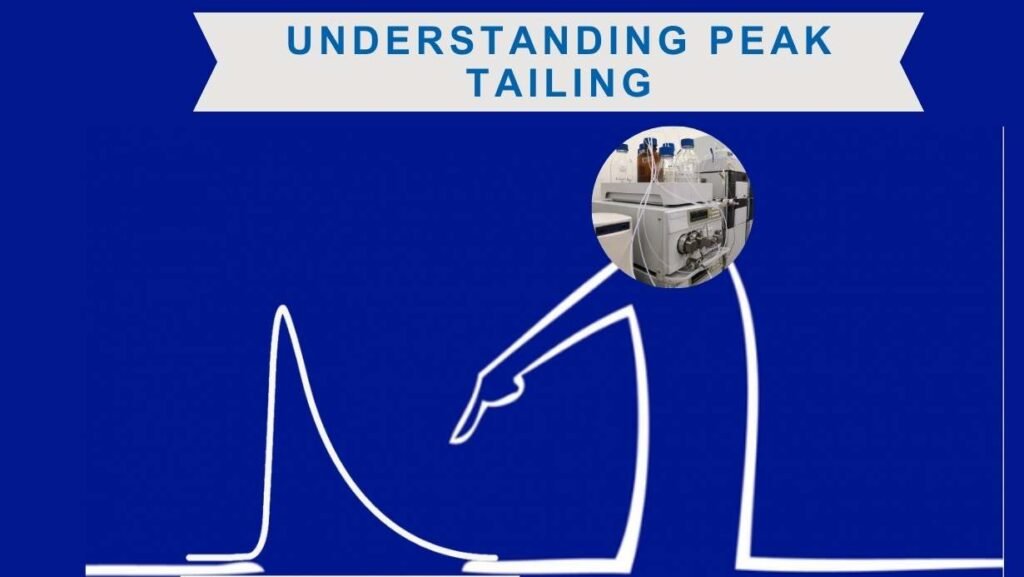Chromatography being a cornerstone of analytical chemistry, is pivotal in separating and analyzing compounds in complex mixtures with remarkable precision. However, chromatographers often grapple with ‘peak tailing,’ a distortion in chromatographic peaks that can compromise analysis accuracy and efficiency.
This article delves into the various causes of peak tailing, elucidating its causes and offering systematic troubleshooting strategies to ensure precise and reliable chromatographic results.
Understanding Peak Tailing

In an ideal scenario, a chromatographic peak should exhibit a symmetrical, or Gaussian, shape with a narrow width, where both peak edges are mirroring each other. The primary cause of peak tailing is the occurrence of multiple mechanisms of analyte retention, with compounds having amine and other basic functional groups interacting strongly with ionised silanol groups on the silica support surface, leading to tailing peaks.
Several factors can lead to peak tailing, resulting in a phenomenon where the trailing edge of a chromatographic peak extends further than its leading edge. This can have profound consequences on the accuracy and reliability of the analytical results. Peak tailing can lead to several adverse outcomes, including decreased resolution between peaks, and inaccurate quantification, leading to potentially erroneous conclusions.
Peak Tailing Calculations
Throughout literature and online research, peak tailing can be quantified using metrics such as the Tailing Factor, Asymmetry Factor and Symmetry Factor. Let’s not get confused with the terms and provide an explanation:
USP
According to USP (General Chapter <621>), there is no difference between the Tailing Factor, Asymmetry Factor and Symmetry Factor, meaning all these 3 terms are the same. Here is the formula USP uses to quantify peak tailing through the Symmetry factor (As):
As = W0.05/2d, where
W = Width of the peak at one-twentieth of the peak height (Width at 5% height)
d = Distance between the perpendicular dropped from the peak maximum and the leading edge of the peak at one-twentieth of the peak height (front width at 5% height)
Ph. Eur
In Ph. Eur, General Chapter for Chromatographic separation techniques (2.2.46), the peak tailing calculation approach is the same as in the USP (same calculation formula used). The only difference that can be observed between USP and Ph. Eur regarding peak tailing is that in Ph. Eur, there is no mention of the terms “Asymmetry Factor” or “Tailing Factor”, meaning only the term “Symmetry Factor” is mentioned in the testing procedures written in Ph. Eur.
Peak Tailing Assessment
The ideal value for the Symmetry Factor is considered 1.0, indicating perfect symmetry of the peak. In both USP and Ph. Eur, if a peak has As > 1.0, it is considered that the peak has a tailing, and when the peak has As < 1.0, the peak has a fronting.
The general Acceptance Criteria for Symmetry Factor in both monographs is 0.8 – 1.8 unless otherwise stated for specific tests.
Causes of Peak Tailing
At the core, peak tailing stems from unequal interactions between the analyte, stationary phase, and mobile phase. It can arise from various factors, including chemical interactions, column issues, or instrumental factors.
Silanol Interactions
Silanol groups on the surface of silica-based columns can interact with primary functional groups of the analyte, leading to secondary interactions and peak tailing. This interaction is more pronounced at mid-pH, where silanols are ionized.
Pro Tip: Performing chromatographic separations at a lower pH can minimize silanol interactions and reduce peak tailing caused by acidic silanol groups. Lowering the pH ensures the protonation of ionizable residual silanol groups, minimizing their interaction with analyte molecules. However, it is important to note that operating at a lower pH may lead to a decrease in retention time for ionizable basic analytes. In such cases, reducing the organic modifier content of the mobile phase can help mitigate this effect.
Unprotonated Acids
Unprotonated acids can compete with protonated silanols for hydrogen ions, causing peak tailing. This competition occurs at low pH values.
Pro Tip: Buffering the mobile phase can help control pH and reduce peak tailing caused by unprotonated acids.
Mobile Phase and pH
The mobile phase composition and pH play a crucial role in peak tailing. Operating close to an analyte’s pKa can result in inconsistent and tailing peaks. Buffers in the mobile phase can help maintain a stable pH and mask residual silanol interactions, thereby reducing peak tailing.
Pro Tip: Select the appropriate buffer concentration to achieve optimal peak shape. Buffers should be selected based on the analyte’s pKa and the desired separation conditions. Increasing the buffer concentration at mid-pH can effectively reduce peak tailing. Additionally, consider using alternative organic modifiers, such as acetonitrile or methanol, to minimize secondary interactions and improve peak shape.
Packing Bed Deformation
Deformation of the column packing bed can lead to peak tailing. This can be caused by voids at the column inlet, channels in the packing bed, or particle accumulation at the inlet frit. Regular replacement of solvent filters, use of in-line filters, and guard columns can help avoid blockage of column frits and minimize column bed deformation.
Pro Tip: Check for the presence of a column void or a partially blocked inlet frit. Substituting the column with a new one can quickly confirm if column bed deformation is the cause of peak tailing. If a void is suspected, reversing the column and washing it with a strong solvent can help remove any blocking contamination.
Column Overload
Column overload can lead to peak tailing and compromised separation. If all peaks exhibit tailing, consider the possibility of column overload. Diluting the sample and re-evaluating the peak shapes can help determine if column overload is the cause.
Pro Tip: To prevent column overload, use a higher-capacity stationary phase with increased carbon content or pore size. Additionally, using a column with a larger diameter or reducing the sample amount or volume injected can help alleviate column overload and improve peak shape.
Excessive Column Dead Volume
Dead volume, or void volume, refers to the volume in the chromatographic system outside the analytical column where the sample can reside or travel through, but no separation occurs. This can lead to band spreading and result in broader, tailed peaks. Because of this, excessive column dead volume can affect the peak shape of early eluting peaks.
Pro Tip: Ensuring proper pre-packing of the column and using appropriate tubing lengths and internal diameters can help minimize dead volume and improve peak shape. Shorter tubing lengths and narrower internal diameters can help reduce dead volume and improve peak shape.
Use of Inappropriate Columns
The use of inappropriate columns can disrupt the delicate balance of interactions necessary for achieving sharp, symmetric peaks and result in peak tailing. The reasons behind it can be due to stationary phase incompatibility, column dimension mismatch, column temperature sensitivity, etc.
Pro Tip: Use a highly deactivated column, such as an “end-capped” column. End-capping involves treating residual silanol groups to convert them into less polar surface functional groups. This reduces the potential for secondary interactions with polar analyte molecules, resulting in improved peak shape. End-capped columns provide symmetrical peak shapes even with acidic, basic, and highly polar analytes.
Contaminants
Complex matrices can interact unpredictably with analytes or the column, causing tailing. The presence of contaminants in the packing material can enhance secondary interactions and also lead to peak tailing. Using high-quality, pure packing materials can help reduce the presence of contaminants and improve peak shape.
Pro Tip: Solid Phase Extraction (SPE) can be used as a sample clean-up procedure to remove interfering contaminants that may contribute to peak tailing. Consider incorporating SPE techniques into sample preparation protocols to minimize peak tailing caused by contaminants.
Detector issues
Detector issues can indeed affect the shape of the peaks observed in the chromatogram and contribute to peak tailing in certain situations. This can usually occur due to a slow response from the detector, bandwidth limitations, large cell volumes of detectors, improper calibration, inadequate sensitivity settings, damaged or worn-out detector components, etc.
Pro Tip: Regular maintenance and calibration of the detector are essential. Additionally, ensure that the detector is appropriate for the specific chromatography application and that its settings are optimized for the analytes and conditions in use to improve peak shapes and overall chromatographic performance significantly.
SEE ALSO: Good Chromatography Practices Guide
General Troubleshooting Strategies
A systematic approach is essential in pinpointing the exact cause of peak tailing:
- Adjusting Chromatographic Conditions: Experimenting with different column chemistries, altering flow rates, and optimizing gradient profiles can yield improvements in peak shape
- High-efficiency columns: The advent of ultra-high-performance liquid chromatography (UHPLC) has brought columns with smaller particle sizes, offering higher efficiency and better peak shapes
- Column Care: Regular column maintenance, such as proper flushing and storage, can prolong column life and reduce peak distortions
- Sample Preparation: Techniques like pH adjustment, dilution, or SPE can improve peak symmetry by removing matrix interferences or reducing sample complexity
- Instrument Calibration: Ensuring that all instruments are properly calibrated and maintained can prevent many issues related to peak tailing
RELATED ARTICLE: HPLC vs UPLC
FAQ: Peak Tailing in Chromatography
Peak tailing can affect the resolution, accuracy, and reproducibility of chromatographic separations. It can lead to difficulties in quantifying compounds accurately and may interfere with the separation of closely eluting compounds.
If peak tailing is suspected to be caused by the stationary phase, it often varies with different analytes or changes when switching to a column with different chemistry. Testing with a different type or brand of column can help determine this.
SEE ALSO: RP vs NP Chromatography
Yes, adjusting the mobile phase can significantly impact peak shape. Changes in pH, buffer strength, or the addition of modifiers like ion-pairing agents can reduce peak tailing.
Problems with the injector, like partial blockages or sample carryover, can cause peak distortions. Similarly, detector issues such as a large cell volume or slow response time can lead to peak tailing.
Yes, chromatography data systems equipped with diagnostic tools can help identify issues causing peak tailing, such as irregular flow rates or temperature fluctuations.
Regular maintenance of the chromatography system, proper column storage, using the correct mobile phase composition, and ensuring the sample is compatible with the column and system setup are key practices to prevent peak tailing.
Conclusion
Peak tailing in chromatography can be a significant challenge for analytical chemists, affecting the accuracy and resolution of separations. With a combination of sound scientific principles, diligent maintenance, and continuous GxP involvement, chromatographers can overcome this issue and achieve optimal peak shapes. Operating at lower pH, using highly deactivated columns, adjusting mobile phase composition and pH, assessing column bed deformation, avoiding column overload, minimizing excessive dead volume, and optimizing sample clean-up procedures are essential steps in troubleshooting and resolving peak tailing.














